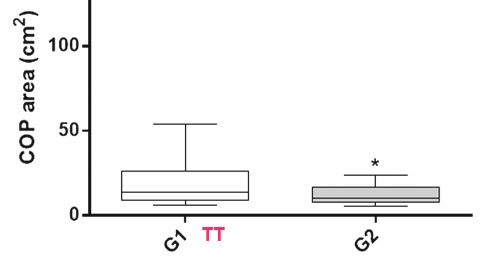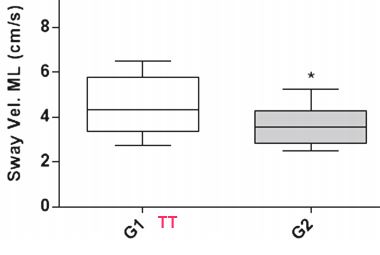Vitamin D receptor (TT), which restricts Vit D to cells, is associated with balance problems in seniors
Postural Balance and Vitamin D Receptor Gene Polymorphism in Physically Independent Older Adults
International Conference on Applied Human Factors and Ergonomics. AHFE 2018:
Advances in Human Factors and Ergonomics in Healthcare and Medical Devices pp 397-404 |
https://doi.org/10.1007/978-3-319-94373-2_44
Regina Poli-Frederico Marcos Fernandes Rubens A. da Silva Karen Fernandes
 Need more balance area (Center of Pressure)
for 1-legged stand: 14 vs 10
Need more balance area (Center of Pressure)
for 1-legged stand: 14 vs 10
 Sway more if TT VDR
Sway more if TT VDR
 ---
Note: Falls are associated with low Vitamin D blood levels
The VDR (TT) restricts how of it actually gets to the cells
* Preventing Falls in Older Adults – Vitamin D combination is the best - JAMA Meta-analysis Nov 2017
* Vitamin D prevents falls – majority of meta-analyses conclude – meta-meta analysis Feb 2015
* Falls cut in half by 100,000 IU vitamin D monthly - RCT 2016
Falls and Fractures category contains the following summary
{include}
Vitamin D Receptor category has the following
{include}
---
Note: Falls are associated with low Vitamin D blood levels
The VDR (TT) restricts how of it actually gets to the cells
* Preventing Falls in Older Adults – Vitamin D combination is the best - JAMA Meta-analysis Nov 2017
* Vitamin D prevents falls – majority of meta-analyses conclude – meta-meta analysis Feb 2015
* Falls cut in half by 100,000 IU vitamin D monthly - RCT 2016
Falls and Fractures category contains the following summary
{include}
Vitamin D Receptor category has the following
{include}
PDF is available free at Sci-Hub 10.1007/978-3-319-94373-2_44
This study aimed to assess the association between VDR polymorphisms and postural balance in physically independent elderly. 142 elderly persons were enrolled at this case-control study. In order to assess the balance, the individuals performed three 30-s trials of one-legged stance balance test on a BIOMEC400 force-platform (EMG System of Brazil, SP Ltda.), following a standardized protocol (with 30 s of rest between each trial). The main balance parameters used for analysis were: center of pressure area (COP), sway velocity (cm/s) and frequency (s) in both the antero-posterior (A/P) and the medio-lateral (M/L) axes. The VDR TaqI polymorphism analysis was by PCR-RFLP. The case group showed lower values of COP, sway velocity in A/P and M/L axes (p = 0.0007). Similar data were observed regarding frequency in A/P (p = 0.04) and M/L axes (p = 0.03). Therefore, carriers of the “C” allele have a better postural balance when compared to individuals with “T” allele.
References
- Fleg, J.L., Morrell, C.H., Bos, A.G., Brant, L.J., Talbot, L.A., Wright, J.G., et al.: Accelerated longitudinal decline of aerobic capacity in healthy older adults. Circulation 112, 674–682 (2005)
CrossRefGoogle Scholar
- Corriveau, H., Prince, F., Hebert, R., Raiche, M., Tessier, D., Maheux, P., et al.: Evaluation of postural stability in elderly with diabetic neuropathy. Diab. Care. 23, 1187–1191 (2000)
CrossRefGoogle Scholar
- Horak, F.B., Shupert, C.L., Mirka, A.: Components of postural dyscontrol in the elderly: a review. Neurobiol. Aging 10, 727–738 (1989)
CrossRefGoogle Scholar
- Hughes, M.A., Duncan, P.W., Rose, D.K., Chandler, J.M., Studenski, S.A.: The relationship of postural sway to sensorimotor function, functional performance, and disability in the elderly. Arch. Phys. Med. Rehab. 77, 567–572 (1996)
CrossRefGoogle Scholar
- Stelmach, G.E., Teasdale, N., Di Fabio, R.P., Phillips, J.: Age related decline in postural control mechanisms. Int. J. Aging Hum. Dev. 29, 205–223 (1989)
CrossRefGoogle Scholar
- Woollacott, M.H., Shumway-Cook, A.: Changes in posture control across the life span—a systems approach. Phys. Ther. 70, 799–807 (1990)
CrossRefGoogle Scholar
- Ji, G.R., Yao, M., Sun, C.Y., Li, Z.H., Han, Z.: BsmI, TaqI, ApaI and FokI polymorphisms in the vitamin D receptor (VDR) gene and risk of fracture in Caucasians: a meta-analysis. Bone 47, 681–686 (2010)
CrossRefGoogle Scholar
- Fang, Y., Rivadeneira, F., van Meurs, J.B., Pols, H.A., Ioannidis, J.P., Uitterlinden, A.G.: Vitamin D receptor gene BsmI and TaqI polymorphisms and fracture risk: a meta-analysis. Bone 39, 938–945 (2006)
CrossRefGoogle Scholar
- Aerssens, J., Dequeker, J., Peeters, J., Breemans, S., Broos, P., Boonen, S.: Polymorphisms of the VDR, ER and COLIA1 genes and osteoporotic hip fracture in elderly postmenopausal women. Osteoporos. Int. 11, 583–591 (2000)
CrossRefGoogle Scholar
- Alvarez-Hernández, D., Naves, M., Díaz-López, J.B., Gómez, C., Santamaría, I., Cannata-Andía, J.B.: Influence of polymorphisms in VDR and COLIA1 genes on the risk of osteoporotic fractures in aged men. Kidney Int. Suppl. 63, S14–S18 (2003)
CrossRefGoogle Scholar
- Berg, J.P., Falch, J.A., Haug, E.: Fracture rate, pre- and postmenopausal bone mass and early and late postmenopausal bone loss are not associated with vitamin D receptor genotype in a high-endemic area of osteoporosis. Eur. J. Endocrinol. 135, 96–100 (1996)
CrossRefGoogle Scholar
- Chatzipapas, C., Boikos, S., Drosos, G.I., Kazakos, K., Tripsianis, G., Serbis, A., Stergiopoulos, S., Tilkeridis, C., Verettas, D.A., Stratakis, C.A.: Polymorphisms of the vitamin D receptor gene and stress fractures. Horm. Metab. Res. 41, 635–640 (2009)
CrossRefGoogle Scholar
- Feskanich, D., Hunter, D.J., Willett, W.C., Hankinson, S.E., Hollis, B.W., Hough, H.L., Kelsey, K.T., Colditz, G.A.: Vitamin D receptor genotype and the risk of bone fractures in women. Epidemiology 9, 535–539 (1998)
CrossRefGoogle Scholar
- Bischoff-Ferrari, H.A., Dawson-Hughes, B., Staehelin, H.B., et al.: Fall prevention with supplemental and active forms of vitamin D: a meta-analysis of randomised controlled trials. BMJ 339, b3692 (2009)
CrossRefGoogle Scholar
- Gillespie, L.D., Robertson, M.C., Gillespie, W.J., et al.: Interventions for preventing falls in older people living in the community. Cochrane Database Syst. Rev. 9, CD007146 (2012)
Google Scholar
- Davidson, B.S., Madigan, M.L., Nussbaum, M.A.: Effects of lumbar extensor fatigue and fatigue rate on postural sway. Eur. J. Appl. Physiol. 93, 183–189 (2004)
CrossRefGoogle Scholar
- Gribble, P.A., Hertel, J.: Effect of hip and ankle muscle fatigue on unipedal postural control. J. Electromyog. Kinesiol. 14, 641–646 (2004)
CrossRefGoogle Scholar
- Rizzoli, R., Stevenson, J.C., Bauer, J.M., Van Loon, L.J., Walrand, S., Kanis, J.A., Cooper, C., Brandi, M.L., Diez-Perez, A., Reginster, J.Y.: ESCEO Task Force. The role of dietary protein and vitamin D in maintaining musculoskeletal health in postmenopausal women: a consensus statement from the European Society for Clinical and Economic Aspects of Osteoporosis and Osteoarthritis (ESCEO). Maturitas 79, 122–132 (2014)
CrossRefGoogle Scholar
- Hildebrand, R.A., Miller, B., Warren, A., Hildebrand, D., Smith, B.J.: Compromised vitamin D status negatively affects muscular strength and power of collegiate athletes. Int. J. Sport Nutr. Exerc. Metab. 26, 558–564 (2016)
CrossRefGoogle Scholar
- Gifondorwa, D.J., Thompson, T.D., Wiley, J., Culver, A.E., Shetler, P.K., Rocha, G.V., Ma, Y.L., Krishnan, V., Bryant, H.U.: Vitamin D and/or calcium deficient diets may differentially affect muscle fiber neuromuscular junction innervation. Muscle Nerve 54, 1120–1132 (2016)
CrossRefGoogle Scholar
- Takkouche, B., Montes-Martinez, A., Gill, S.S., Etminan, M.: Psychotropic medications and the risk of fracture: a meta-analysis. Drug Saf. 30, 171–184 (2007)
CrossRefGoogle Scholar
- Holbein, J.M.A., Dermott, M.C.K., Shaw, C., Demchak, J.: Validity of functional stability limits as a measure of balance in adults aged 23–73 years. Ergonomics 50, 631–646 (2007)
CrossRefGoogle Scholar
- Pollock, A.S., Durward, B.R., Rowe, P.J., Paul, J.P.: What is balance? Clin. Rehabil. 14, 402–406 (2000)
CrossRefGoogle Scholar
- Nguyen, D.T., Kiel, D.P., Li, W., Galica, A.M., Kang, H.G., Casey, V.A., et al.: Correlations of clinical and laboratory measures of balance in older men and women. Arth. Care Res. 64, 1895–1902 (2012)
CrossRefGoogle Scholar
- Hurvitz, E.A., Richardson, J.K., Werner, R.A., Ruhl, A.M., Dixon, M.R.: Unipedal stance testing as an indicator of fall risk among older outpatients. Arch. Phys. Med. Rehabil. 81, 587–591 (2000)
CrossRefGoogle Scholar
- Boersma, D., Demontiero, O., Mohtasham, A.Z., Hassan, S., Suarez, H., Geisinger, D., Suriyaarachchi, P., Sharma, A., Duque, G.: Vitamin D status in relation to postural stability in the elderly. J. Nutr. Health Aging. 16, 270–275 (2012)
CrossRefGoogle Scholar
- Haetholt, K.A.: [Cost]effectiveness of withdrawal of fall-risk increasing drugs versus conservative treatment in older fallers: design of a multicenter randomized controlled trial (IMPROveFALL-study). BMC Geriatri. 11, 48 (2011)
CrossRefGoogle Scholar
